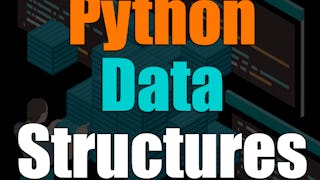This comprehensive beginner-level course equips learners with the skills to build, configure, and deploy full-featured web applications using the Python Pyramid framework. Through six progressively structured modules, learners will explore the core components of Pyramid, from setting up a virtual environment and configuring routing to designing scalable view logic, handling forms, and applying advanced rendering techniques.
您将获得的技能
要了解的详细信息

添加到您的领英档案
July 2025
18 项作业
了解顶级公司的员工如何掌握热门技能

该课程共有6个模块
This module introduces learners to the Pyramid microframework and prepares the development environment using VirtualBox and Ubuntu. It guides the setup of essential dependencies, establishes the foundation for WSGI-based application development, and explores how Pyramid compares with other Python web frameworks. The module culminates in the creation of a basic Pyramid application, enabling learners to apply key architectural concepts and validate their setup.
涵盖的内容
7个视频3个作业
This module explores how Pyramid handles templates, asset specifications, and dynamic response rendering. Learners will examine view callables using both functions and classes, utilize multiple rendering engines, and understand how Pyramid automatically processes return values using response adapters. The module also focuses on performance enhancement through HTTP caching, introduces techniques for automating configuration using config.include(), and provides insight into advanced features like introspection and declarative configuration using decorators.
涵盖的内容
8个视频3个作业
This module guides learners through the practical steps of configuring, creating, and running a Pyramid web application. Beginning with a basic “Hello World” setup, the lessons explain the use of the WSGI server, routing mechanisms, and the essential configuration methods needed to map URLs to view callables. Learners also gain hands-on experience with setting up a Pyramid project using scaffolding tools, understanding the structure of a Pyramid package, and identifying the function of key directories such as templates/, static/, and __init__.py. By the end of this module, learners will be equipped to build and run a fully functional Pyramid application with proper configuration and project organization.
涵盖的内容
7个视频3个作业
This module provides an in-depth look at how Pyramid handles routing in web applications. Learners explore URL dispatching, dynamic and static route configuration, and the process of matching incoming requests to appropriate view callables. The module introduces route patterns, route matching order, and tools for generating URLs dynamically. It also covers the setup of static routes for serving assets like CSS and JavaScript, along with powerful debugging techniques using match dictionaries and predicates. Advanced topics such as predicate callables and route factories are also introduced to enable conditional routing and context-driven view resolution.
涵盖的内容
9个视频3个作业
This module explores the core concept of view callables in Pyramid, demonstrating how they receive requests, generate responses, and integrate with Pyramid’s routing and templating systems. Learners will understand how to define view callables using functions, classes, or callable objects and how to handle HTTP exceptions within views. The module also introduces practical techniques for handling form submissions, using built-in renderers such as JSON and Chameleon templates, and returning structured responses. By the end, learners will be able to construct interactive, form-driven web interfaces that respond dynamically to user input using Pyramid's flexible view and rendering system.
涵盖的内容
6个视频3个作业
This module focuses on advanced rendering techniques and template handling within Pyramid applications. Learners will explore how to manipulate response attributes such as content type and charset, use system values in templates, and directly control rendering behavior using built-in and custom renderers. The module introduces template macros for creating reusable UI components and explains how Pyramid integrates with Chameleon for efficient and maintainable server-side rendering. Attention is also given to the side effects of improper escaping and best practices for template structure and rendering performance.
涵盖的内容
6个视频3个作业
从 Software Development 浏览更多内容
 状态:预览
状态:预览 状态:免费试用
状态:免费试用Microsoft
人们为什么选择 Coursera 来帮助自己实现职业发展




学生评论
23 条评论
- 5 stars
73.91%
- 4 stars
26.08%
- 3 stars
0%
- 2 stars
0%
- 1 star
0%
显示 3/23 个
已于 Sep 7, 2025审阅
Excellent beginner’s guide to Python Pyramid; well-structured, easy to follow, with practical examples that build foundational web development skills effectively.
已于 Nov 6, 2025审阅
A solid introduction to Pyramid. The hands-on parts really helped me learn how to structure a project and handle routes. I’d recommend it to anyone curious about lighter Python frameworks.
已于 Sep 25, 2025审阅
Good introduction to Pyramid framework, but lacks real-world examples and deeper project-based learning.
常见问题
To access the course materials, assignments and to earn a Certificate, you will need to purchase the Certificate experience when you enroll in a course. You can try a Free Trial instead, or apply for Financial Aid. The course may offer 'Full Course, No Certificate' instead. This option lets you see all course materials, submit required assessments, and get a final grade. This also means that you will not be able to purchase a Certificate experience.
When you purchase a Certificate you get access to all course materials, including graded assignments. Upon completing the course, your electronic Certificate will be added to your Accomplishments page - from there, you can print your Certificate or add it to your LinkedIn profile.
Yes. In select learning programs, you can apply for financial aid or a scholarship if you can’t afford the enrollment fee. If fin aid or scholarship is available for your learning program selection, you’ll find a link to apply on the description page.
更多问题
提供助学金,







